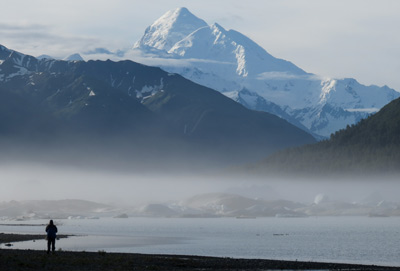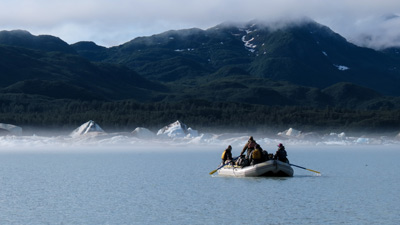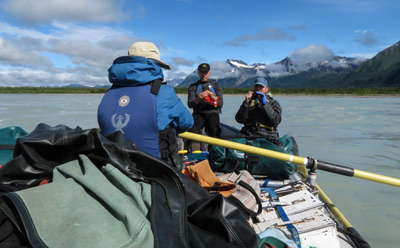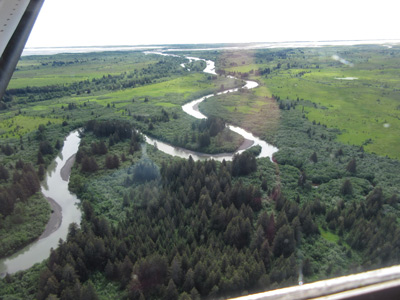Alsek River 2014
Day 12, Saturday, July 5
A surreal day, for sure. Just too many different forms of transportation and a head spinning series of environments. It rained thru most of the night - ugh! I woke up at 4:15 and noticed a light breeze and that the rain had stopped. (That would set an all-time record for Susie and me for near continuous rain while camping: 42 hours. Our previous record was 36 hours, set in Denali National Park in 2012. Not the kind of record you want to be setting.) Got up to groove and saw lots of fog. When I got up again at 5:30, I could see some mountains and lifting fog. Hey, things were looking brighter. We started packing up gear immediately, only taking time to photograph base off Mt Fairweather, before it disappeared in the clouds again. This was at 5:53 am. People seemed to be running out to take some photos. Pent up needs after all that rain.
 By 6:31, the peak of
Fairweather started to become visible. Who needs to eat breakfast when
the photography is getting this good? But we did have a quick one, of
smoked salmon, bagels and cream cheese. By 8:15, we had completely
broken camp and were casting off. But the next two hours would blow us
away. The clouds were lifting and we could see in all directions. What
a special time. Since we had managed to get away a few minutes early,
the boats werepaddled out a bit into the lake, staying away from the
monster icebergs. Paul and Scott, in the rear of our boat, being
paddled by Joe, could NOT stop taking photos. Hey, if you have the
battery power and space on your memory cards, go for it. (BTW, Paul’s
head did not “explode” but I did notice some swelling……)
By 6:31, the peak of
Fairweather started to become visible. Who needs to eat breakfast when
the photography is getting this good? But we did have a quick one, of
smoked salmon, bagels and cream cheese. By 8:15, we had completely
broken camp and were casting off. But the next two hours would blow us
away. The clouds were lifting and we could see in all directions. What
a special time. Since we had managed to get away a few minutes early,
the boats werepaddled out a bit into the lake, staying away from the
monster icebergs. Paul and Scott, in the rear of our boat, being
paddled by Joe, could NOT stop taking photos. Hey, if you have the
battery power and space on your memory cards, go for it. (BTW, Paul’s
head did not “explode” but I did notice some swelling……)
It was scenic overload to the max, looking back upstream: big river, lovely clouds, mountain peaks and, of course, lots and lots of glaciers. Even the guides were taking photos. Nearby, we floated past a couple of stranded icebergs. When we would turn and look downriver, we could see we were entering a different world: the coastal plain. The land was flat and the river seemed in a hurry to get to the ocean. We noticed a few cabins on the high banks on river left. We were now in the “Preserve” part of Glacier Bay National Park and Preserve. Typically, hunting and more motorized use is permitted in the “preserve” parts of the Alaska National Parks.
 We noticed Sam’s boat making
its way to river left and knew that the river part of our Alsek trip
was coming to a close. It was 10:25 am when our raft beached on a
gravel strip. We were at what is known as the Dry Bay Fishing Camp.
Well, sort of. Now, things started happening very quickly. The first
thing was that a Park Service Ranger pulled up in her ATV, and started
talking with Sam. Apparently, she was here to pick up the entrance fee
for the National Park. Susie and I immediately thought: hey, we could
show her our Senior Passes and pay for over half the group. My
suspicion is that commercial, permitted trips don’t work that way.
Some mentioned that our first night at Gateway Knob, we saw a
helicopter flying up river that turned to go on the west side of the
Knob. We never saw or heard it again, and this seemed of interest to
the Ranger. It was then that she told us about the Canadian Group that
took two days to portage through Door #3, or the so-called Portage
Channel. We learned then that our guides had been sweating bullets
over what our group would encounter. (NOW they tell us. I guess the
guides are trained not to worry their clients.) So I guess we dodged
one of those bullets, for sure.
We noticed Sam’s boat making
its way to river left and knew that the river part of our Alsek trip
was coming to a close. It was 10:25 am when our raft beached on a
gravel strip. We were at what is known as the Dry Bay Fishing Camp.
Well, sort of. Now, things started happening very quickly. The first
thing was that a Park Service Ranger pulled up in her ATV, and started
talking with Sam. Apparently, she was here to pick up the entrance fee
for the National Park. Susie and I immediately thought: hey, we could
show her our Senior Passes and pay for over half the group. My
suspicion is that commercial, permitted trips don’t work that way.
Some mentioned that our first night at Gateway Knob, we saw a
helicopter flying up river that turned to go on the west side of the
Knob. We never saw or heard it again, and this seemed of interest to
the Ranger. It was then that she told us about the Canadian Group that
took two days to portage through Door #3, or the so-called Portage
Channel. We learned then that our guides had been sweating bullets
over what our group would encounter. (NOW they tell us. I guess the
guides are trained not to worry their clients.) So I guess we dodged
one of those bullets, for sure.
 Next, here comes Bill and his
wife driving two ATVs that are pulling a trailer. Bill is the guy who
runs what he calls the Dry Bay limo service. He would be the one to
shuttle all our gear and us to the air strip that the bush flight
would use to get us out of here. It used to be that the take out point
was a few miles away, essentially within a hundred yards or so of the
end of the air strip. But as glaciers have melted, the land is
carrying less weight on it, and so the land rises, which changes the
course of the river. It was at this point that Sarah told us that
where we were standing now on elevated dry ground was, 10 years ago, a
major channel of the river. Indeed, in satellite imagery from 2005,
you can see the gravel on which we unloaded, but there is a major
channel that appears to be raft-able, all the way to the air strip. By
mid-August of 2007, the channel is still there, but it appears very
narrow in many spots. Thus, the need for a shuttle of a couple of
miles or so to the air strip.
Next, here comes Bill and his
wife driving two ATVs that are pulling a trailer. Bill is the guy who
runs what he calls the Dry Bay limo service. He would be the one to
shuttle all our gear and us to the air strip that the bush flight
would use to get us out of here. It used to be that the take out point
was a few miles away, essentially within a hundred yards or so of the
end of the air strip. But as glaciers have melted, the land is
carrying less weight on it, and so the land rises, which changes the
course of the river. It was at this point that Sarah told us that
where we were standing now on elevated dry ground was, 10 years ago, a
major channel of the river. Indeed, in satellite imagery from 2005,
you can see the gravel on which we unloaded, but there is a major
channel that appears to be raft-able, all the way to the air strip. By
mid-August of 2007, the channel is still there, but it appears very
narrow in many spots. Thus, the need for a shuttle of a couple of
miles or so to the air strip.
Anyway, Bill reported that there was a change in today’s schedule, as far as the bush flights were concerned. Because of the gear and number of clients, Sobek apparently decided that it would be better (and cheaper for them) to fly in a turbo-charged Otter. The Otter either seats 10 passengers and limited gear, or could hold all the gear that had to go back to Haines, three guides (who also were going back to Haines), and one client. Sobek would then pay for air service from Haines back to Juneau for the single client, since all of the clients had purchased (on their own) tickets on the Alaska Airlines flight from Yakutat to Juneau. The advantage to the client would be that, since the weather was still pretty good, the flight essentially due east to Haines would be a scenic mind blower. Paul immediately volunteered. (And his subsequent photos prove he made the correct choice).
After flying to Haines (ca. 110 airline miles to the east), the Otter would disgorge all the gear and passengers and fly back to the Dry Bay airstrip, and pick the remaining clients up and fly them to Yakutat to meet the commercial flight. Any time there is a change in plans, of course, I start, well, not worrying, but concerning myself. The original plan was to have several shuttle flights between Dry Bay and Yakutat. Of course, if the weather changed, and grounded the Otter in Haines or something, then we would be cooling our heals in Dry Bay, sans tents. (There really is nothing there, other than an old fishing camp and a few apparently deserted buildings.
So the first thing was to empty all the rafts of gear, and make sure that things like our tents were on a pile going to Haines, and our big dry bags, used for our personal gear (and in our case our sleeping bags), were in a pile headed to Yakutat. The rafts were washed (at least it was a nice, sunny morning) and deflated, and the frames disassembled. To aid in deflation, we all sat on the raft walls to provide pressure to push the air out. Then, the little trailers were loaded with gear and a guide or two, and the ATVs took off for the airstrip. At some point, someone remembered that since all the guides and virtually all of the Sobek Gear was going to Haines, we needed to leave behind some lunch materials for the ten clients that would be waiting sans guides at the Dry Bay air strip. Good idea!! Bill returned with his ATV to take most of the remaining clients and guides to help with the loading of the plane, once it came in. So it was time to say goodbye to the guides. Always an emotional time.
Roger B., MJ, Susie, Sarah and I were left at the take out point. Amalia promised us that she would manage lunch so that not all of the cookies would be consumed before we would be hauled to the airstrip. We could hear the plane come in around 12:30 pm, but it did not leave again until 1:15. So it must have taken a while to squeeze in all the gear. About 20 minutes after the plane left (we could hear it and did see it once it cleared the trees) Bill showed up with his ATV. We somehow loaded all five of us, with our green dry bags and day packs, into the rear of the little trailer being pulled by the ATV and we were off. Bill told us that the pilot of the Otter had reported that it would be a two hour round trip (Dry Bay to Haines, dump people and gear and fly back to Dry Bay). I thought that was a bit optimistic, but I would be proved wrong.
 Finally, 10 of the 11 clients
were reunited at the beautiful Dry Bay airstrip (it did have some
gravel in places, but was mostly grass). Amalia had already spread out
lunch and was riding herd to make sure Thelonious did not inhale all
the cookies. Actually, they all waited until we arrived before we
started lunch. There were actually cookies waiting to be eaten.
Excellent. Anyway, we all ate as much as we could, but there was still
food, especially bread, left over. (Susie figured out how to carry it
back home in her carry-on and we enjoyed for a couple of weeks after
the trip.) Then we waited. I walked out to the former take out point.
My my, it was a pool, and a swamp, or something like that. How things
change. Quickly.
Finally, 10 of the 11 clients
were reunited at the beautiful Dry Bay airstrip (it did have some
gravel in places, but was mostly grass). Amalia had already spread out
lunch and was riding herd to make sure Thelonious did not inhale all
the cookies. Actually, they all waited until we arrived before we
started lunch. There were actually cookies waiting to be eaten.
Excellent. Anyway, we all ate as much as we could, but there was still
food, especially bread, left over. (Susie figured out how to carry it
back home in her carry-on and we enjoyed for a couple of weeks after
the trip.) Then we waited. I walked out to the former take out point.
My my, it was a pool, and a swamp, or something like that. How things
change. Quickly.
I was out at the airstrip taking photos of the view, with lupine in the foreground, when I heard a plane, and looked at my watch. By golly, it was just a couple of minutes before 3:15. Sure enough, here came the turbocharged Otter of Yakutat Coastal Airways. The pilot landed and pulled up right near where we had all our gear piled up. It took him a few minutes to load our dry bags, which would become luggage, and then we climbed in. Susie and I sat on opposite sides of the plane, to get better photo coverage. The pilot climbed in, revved up the engine and we took off for Yakutat, Alaska. Basically, it is about 47 miles northwest, right along the coast. One of the advantage of this route is that, for a bush flight, it is relatively reliable, since the pilot, even in bad weather, can fly right up the beach. In this case, we flew at what I estimated to be about 1500 feet off the deck, which made for a pretty bumpy flight. But heck, it was less than 30 minutes, so not too bad.
Some of the literature we were provided by Sobek suggested that one could get a shower at the lodge at the Yakutat airport for $10. After we landed and were checking in for the Alaska Airlines flight (which did not leave for a couple of hours), I looked into such, simply because I thought it might feel good to take a nice hot shower. Well, the policy of the lodge had changed: no showers unless four of us wanted to rent a room for $125 and take showers. I thought, well, I don’t need/want one that bad. So we went ahead and checked our dry bags for the flight back to Juneau, and headed over to the bar in the “lodge” at the airport. Susie even broke down and had a glass of wine. The bar seemed to be the main waiting room for the airport. And it seemed to be filling with fishermen and women. Fishing seems to be THE tourist activity around Yakutat. I was amazed to see the piles of 50 pound boxes of frozen fish some folks were shipping home.
The Alaska Airlines flight arrived on time, and I must say, the plane was pretty full flying to Juneau. Weather was cloudy when we arrived in Juneau. We were met by a representative of AKD/MTS, who had picked up all of our “city” gear and luggage. We could tell by the tags on it that it had been shipped by seaplane from Haines to Juneau. We all piled into the AKD/MTS van, hugs and handshakes all around, and were taken to our respective motels. Roger B was staying in the same one that Sarah, Susie and I were. After cleaning up, Sarah, Susie and I took a walk to see what we could get for dinner. Ultimately, Susie and I ordered a Domino’s pizza, took it back to the room, and ended up giving Roger B the remainder of it. So that was our day. We woke up on the shores of Alsek Lake, took a raft to Dry Bay, then an ATV trailer to an airstrip, transported by bush flight to Yakutat, then a B-737 to Juneau, and a van to our motel. And so ended our Alsek River trip. Some final thoughts and recommendations in the Epilogue.
Additional Photos and videos can be found here: The Alsek Days 9 - 12 album on our SmugMug Photo Album Site
You might enjoy reading a different perspective on this same trip: Sarah Boomer's Report on the Thermophile.org website
© Roger A. Jenkins & Suzanne A. McDonald, 2014, 2016
